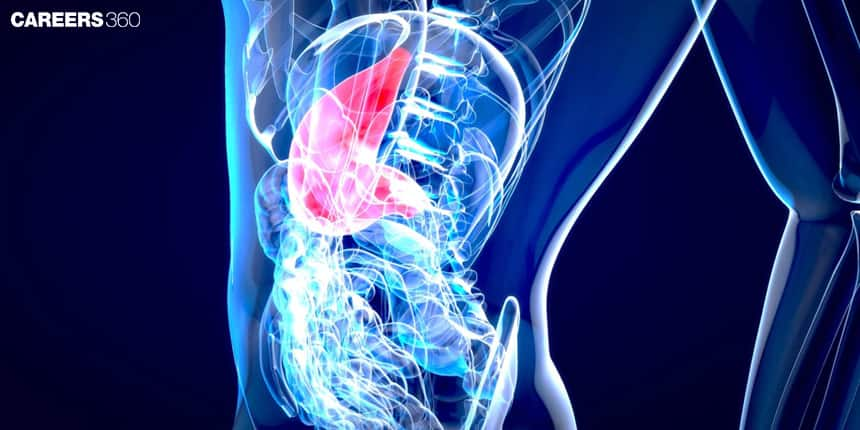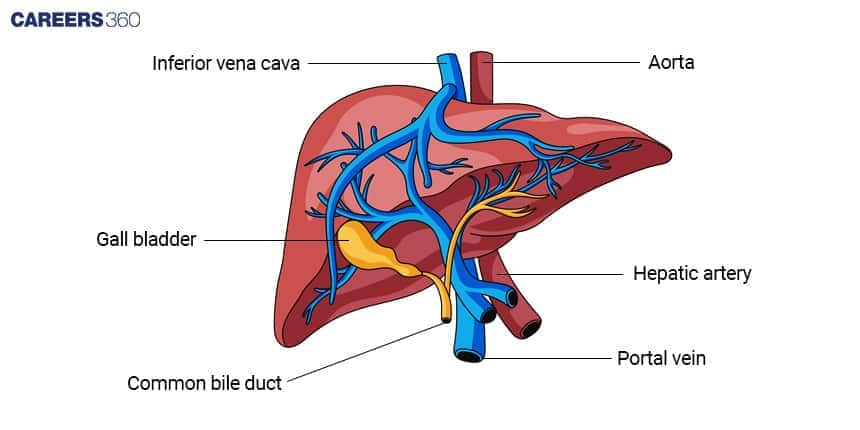The Liver and Its Functions
Liver
The liver is a vital organ in the human body. It is situated in the upper right abdomen and has a unique structure formed of two main lobes combined with many smaller units called lobules. The liver carries out various important functions that include digestion, metabolism, detoxification, and storage of nutrients. This is one of the important topics from the Digestion and Absorption chapter in Biology.
NEET 2025: Mock Test Series | Syllabus | High Scoring Topics | PYQs
NEET Important PYQ's Subject wise: Physics | Chemistry | Biology
New: Meet Careers360 B.Tech/NEET Experts in your City | Book your Seat now
- Liver
- Functions of the Liver
- Anatomy of the Liver
- Liver Diseases

Key Facts
- The liver filters all of the blood in the body and breaks down poisonous substances, such as alcohol and drugs.
- The liver also produces bile, a fluid that helps digest fats and carry away waste.
- The liver consists of four lobes, which are each made up of eight sections and thousands of lobules (or small lobes).
The liver is one of the most vital organs in terms of human physiology, credited with maintaining different crucial activities that help keep a person's health in good condition. It is responsible for the detoxification of toxins and also other harmful substances. One of the major functions of liver production of bile which plays a very important role in the absorption and digestion process.
Functions of the Liver
It is one of the most vital organs performing a wide range of crucial functions related to the maintenance of overall health. There are more than 10 functions of the liver. They can be broadly categorised into metabolic processes and detoxification.
Metabolic Functions
Protein metabolism: It synthesises important proteins like albumin, which helps in maintaining blood volume, and clotting factors necessary for blood coagulation.
Carbohydrate metabolism: It stores glucose in the form of glycogen and releases it in amounts needed to maintain blood sugar.
Lipid metabolism: The liver is a significant organ for regulating cholesterol synthesis and degradation. It plays a critical role in lipid metabolism.
Detoxification
Biotransformations by the liver change drugs and other toxins into forms readily excreted by the body.
Bile production
The liver produces bile, which contains bile salts which aids the digestion of fats and removes waste products from the body.
Anatomy of the Liver
The liver is the largest internal organ and always contributes to the overall metabolic balance in the human body. Located in the upper right quadrant of the abdominal cavity under the diaphragm, the organ is majorly situated on the right side. The liver is an example of a complex organ with a clear anatomical structure and function.
Structure and Position of liver
The liver lies in the upper right abdominal quadrant, under the diaphragm.
It extends across the midline to the left side.
Thus, in its anatomic position, it lies at the junction of the blood supply from both the hepatic artery and portal vein.
It is anatomically well-placed for its metabolic and detoxification functions.
The anatomic structure of the liver is divided into four lobes—right, left, caudate, and quadrate.
All these lobes have different functions and different blood supply.
These lobes essentially contain a similar form of tissue, that is, a tissue composed of hepatocytes, which are the main functional cells of the liver grouped into lobules.
The hepatic artery delivers oxygen-rich blood
The portal vein delivers nutrient-rich blood from the gastrointestinal tract—to accomplish metabolic processes in the liver.
Also Read: |
Liver Anatomy:

Histology of Liver
Under the microscope, the tissue of the liver consists of hepatocytes organised into hexagonal lobules.
These project from a central vein, which is at the centre of each lobule.
The hepatocytes are also surrounded by sinusoids and specialised capillaries.
Blood from the hepatic artery and portal vein flows into the sinusoids.
The liver also lodges the Kupffer cells, which are specialised macrophages that form an integral part of the immune function of the liver and its detoxification ability.
Liver Diseases
Liver diseases are a group of disorders characterised by damage to liver structures and functions. The effects result in considerable health problematic situations. These can be caused by various factors, either viral diseases or chronic diseases, and may require special treatment management and care. These include the following:
Hepatitis
Type A, B and C occur due to viral infection and result in inflammation.
Symptoms include Jaundice, Fatigue and Abdominal discomfort.
Treatments are antiviral medications and supportive care.
Liver Cirrhosis
Causes: Prolonged alcohol abuse, chronic viral hepatitis, and other causes which end up with irreversible scarring
Symptoms: Ascites and Hepatic encephalopathy.
Managed by lifestyle modifications. Sometimes Liver Transplantation.
Liver Cancer (Hepatocellular Carcinoma)
It may occur due to underlying liver disease, such as cirrhosis or chronic hepatitis.
Diagnosis may be done with the aid of imaging techniques like CT, MRI, and biopsy. Treatment may vary from surgery to chemotherapy, depending on the stages.
Also Read:
Recommended Video
Liver and Its Histology:
Frequently Asked Questions (FAQs)
During liver disease, there will be yellowing of the skin, one feels very tired, and there could be pain in the lower parts of the stomach area.
Imaging procedures such as CT scans and MRI are done, then biopsy.
The natural foods that benefit the liver most are dark green, leafy vegetables, berries, and cold-water fish rich in omega-3 fatty acids.
Vaccination against hepatitis, moderation of alcohol, and avoidance of excessive weight gain are preventive measures.
The liver produces bile, which aids in the digestion and absorption of lipids and absorbs fat-soluble vitamins.
Also Read
30 Nov'24 03:25 PM
26 Nov'24 05:38 PM
25 Nov'24 06:43 PM
25 Nov'24 05:45 PM
25 Nov'24 04:48 PM
25 Nov'24 03:52 PM
23 Nov'24 04:30 PM
23 Nov'24 10:03 AM